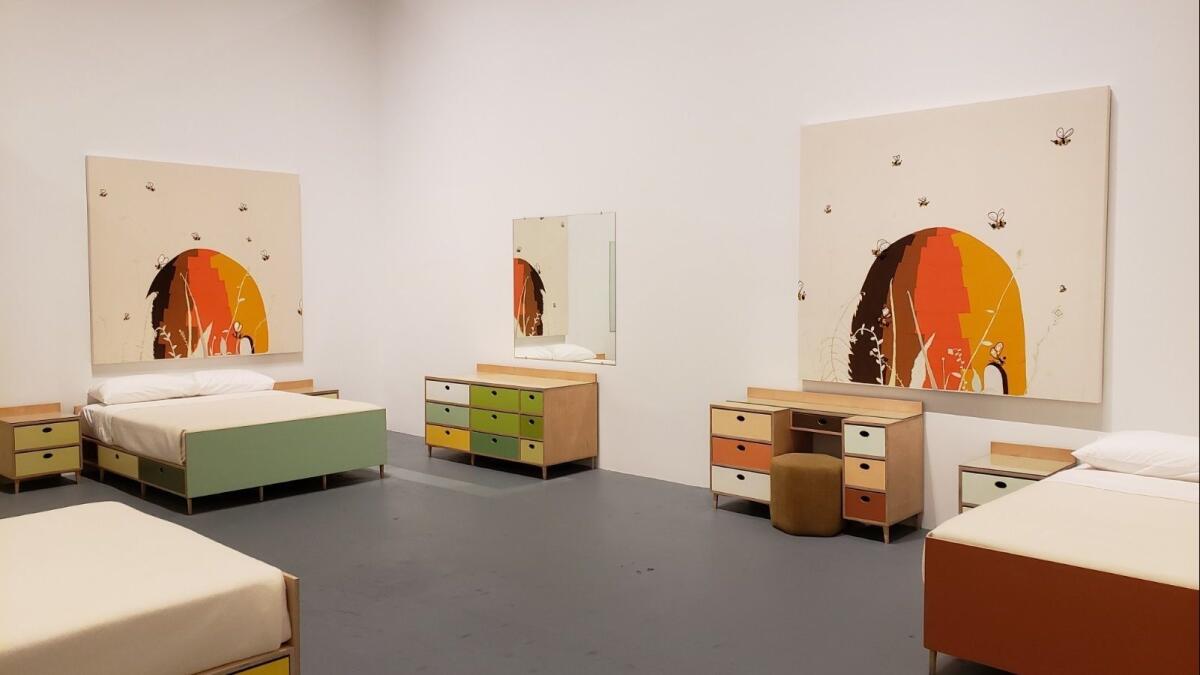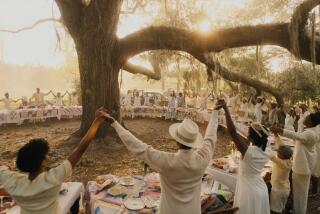Review: Laura Owens’ new MOCA show grasps the perpetual power of taboo

Remember when there were three brows – high, middle and low?
The schema was concocted a century ago from phrenology, an inquiry in which racialism and eugenics masqueraded as science to examine the shape and size of the human cranium as an alleged sign of mental capacity. In simplest (and nuttiest) terms: The higher the forehead, the bigger the brow – and the more brains were supposed to be packed inside.
Two of the three became conventional cues for making and looking at art, at least since cultural critics Russell Lynes and Dwight Macdonald got ahold of them after World War II. In the gruesome wake of Auschwitz and Manzanar, eugenics were scrubbed from the field. Instead, highbrow came to connote a commitment to rarefied refinement, with lowbrow signaling raw vitality.
Each end of the aesthetic spectrum had its fervent champions. (One example is on view at the Petersen Automotive Museum in “Auto-Didactic: The Juxtapoz School,” a group exhibition that features artists since the 1960s who self-identify as lowbrow.) But the big taboo was found elsewhere. The big taboo was middlebrow art.
Highbrow could get an artist into the art museum, while lowbrow could garner rebellious street-cred. But middlebrow? A bland vulgarization that waters down the high and flattens out the low, middlebrow was an art of homogeneous mush. Sometimes called midcult, it would get you blithely ignored.
What serious artist could stand that?
Enter Laura Owens, the Los Angeles artist whose thoroughly entrancing midcareer survey is at the Museum of Contemporary Art’s warehouse space in Little Tokyo. (It’s her second MOCA solo.) In the late 1990s she grabbed midcult by the lapels. She began to make paintings that do not fawn over some supposed virtue of middlebrow culture, but they do grasp the perpetual, ruminative power of taboo. Playing with midcult is playing with artistic fire. She’s great at it.
Her gift shows up straightaway, in the first big painting just inside the show’s entry.
A giant, 11-foot-tall version of a cheap drugstore greeting card is painted in placid blue with a length of rope winding around a cheerful cartoon drawing of a smiling, mop-haired boy and his droopy-eyed shaggy dog. Even if you have never seen these characters before, you feel as if you have. A conventional bit of life-coaching wisdom provides text: “When you come to the end of your rope, make a knot, and hang on.”
Owens has rendered the work as a collection of layered twists. The card appears to have been sliced open from top to bottom along the boy’s head, revealing a second, identical card beneath. It’s a deftly painted illusion, a reference to his interior life exposed as just a mirror image of his external reality.
What you see is what you get. Painted illusions are quickly upended.
Three big smears of paint, two at the top and one near the bottom, are thick enough to cast actual shadows on the canvas — shadows that are further darkened with additional paint. Material reality on the surface of the painting merges with the material reality of the painting that hangs before you on the wall.
The background to boy-and-dog is painted in two blue shades — similar but different, with the lighter hue seemingly brushed on top of the darker one in the manner of a computer graphic scribble. Its edges are slick and precise, not unkempt and brushy. The space of the painting feels digital, not photographic. The pictorial struggle that plays out on the canvas is not between reality and illusion. Instead, real oscillates with hyper-real.
The surface of Owens’ painting sports applied fragments of broken lattice. They suggest a two-dimensional grid — an established formal symbol of Modernist art — but their splintering doubles as a sign that this painting has broken with that tradition. Photography is the language that interrupted the grand tradition of illusionistic painting in the modern era, but now we’ve moved on from that.
Owens’ text even spells it out: This painting is the knot at the end of that rope, so hang on.
The jagged lattice fragments also cast their own shadows across the painting, while a few protrude over the canvas’ edges. They throw shadows on the wall of the gallery in which we are standing. It isn’t often that a painting functions as installation art, incorporating the actual space it shares with the audience. But this one does, and it’s a hallmark of Owens’ work.
Born in Euclid, Ohio, in 1970, the artist came of age during a period when installation art was riding high and painting was dragging low. First at the Rhode Island School of Design, where she studied as an undergraduate, and then at Cal Arts, where she graduated with an MFA in 1994, Owens was up against formidable odds.
In 1998, she collaborated with artist Jorge Pardo on a remarkable installation that today reads as throwing down a gauntlet. He fabricated several bedroom sets — nightstands, vanities, mirrors, dressers and neatly tucked beds — from plywood painted in pale shades of green, tan and orange, while she made simple paintings of beehives in color-coordinated hues. Thick loops of acrylic paint, some seemingly squeezed straight from the tube, form industrious bees buzzing around the hives.
The mirrors reflect the mix-up of painting and sculpture, art and decoration, while the subject of bedroom décor injects a domestic element of private bliss into an installation that is professional and public. (Owens and Pardo were then a couple.) Just outside the MOCA gallery, curators Bennett Simpson and Rebecca Matalon have smartly hung Owens’ large-scale reworking of a small but similarly domestic-professional/public-private image – this one showing two tousled Parisian prostitutes cuddling in a cozy bed, lovingly painted by Henri de Toulouse-Lautrec on a humble piece of cardboard in 1893.
The bedroom collaboration is a site for restorative experiences. Art-as-lifestyle is wittily upended. The beehive decorations slyly evoke the hive mind – a shared effort that can go one of two ways, producing either uncritical conformity or collective intelligence.
Owens’ range of invention, material and conceptual, is absorbing. The show is not big, but plan on spending time. Her work has sources in textiles, newspapers, greeting cards, art, embroidery, Chinese scrolls, folk art, wallpaper and more. Almost all of them are associated with the home, which Owens reconfigures for institutional display.
Paintings of the alphabet are less like austere riffs on Jasper Johns than like something from a child’s bedroom, where the letter S wraps around an owl, the edges of both stitched with yarn, and the letter M is marked by yarn loops in pink, raspberry and tan. The clinical distance created in a silkscreen painting of now-obsolete classified ads for personal relationships, whether long-term or one-night-stands, adds poignance to the yearning desire expressed in them.
A recent painting of broken grids is covered with 18 brightly painted wheels in assorted sizes, from wagon to bicycle, crossing Marcel Duchamp’s Dada high jinks with a thrift-store junk assemblage that might be expected of an anonymous folk artist. A silk-screened list of “amazing facts” is certainly amazing, but once you start getting into it, artistic questions around belief are raised. True or false: “Apples, not caffeine, are more efficient at waking you up in the morning. Marilyn Monroe had six toes. Adolf Hitler’s mother seriously considered having an abortion but was talked out of it by her doctor. Pearls melt in vinegar.”
The traveling show, organized by the Whitney Museum of American Art, ranges from the mid-1990s to the present. (With about 60 works, it has been slightly trimmed from its New York presentation.) The 664-page catalog is short on the usual features of an artist’s monograph, including an exhibition checklist, which disappointingly reduces its usefulness as a record of the splendid undertaking.
Instead, most of it is a mélange of the pack-rat artist’s correspondence, clippings, snapshots, short reminiscences from friends and former teachers, gallery announcements, brief essays, exhibition photographs and more. Together they add up to a casual, surprisingly detailed Owens biography that, without an index, is meant for pleasurable browsing.
The catalog is a scrapbook, in other words, which left me wondering: Is there anything more middlebrow than scrapbooking?
The Geffen Contemporary at MOCA, 152 N. Central Ave., Little Tokyo, (213) 621-2766, through March 25. Closed Tuesday. moca.org
christopher.knight@latimes.com
Twitter: @KnightLAT
christopher.knight@latimes.com
More to Read
The biggest entertainment stories
Get our big stories about Hollywood, film, television, music, arts, culture and more right in your inbox as soon as they publish.
You may occasionally receive promotional content from the Los Angeles Times.







